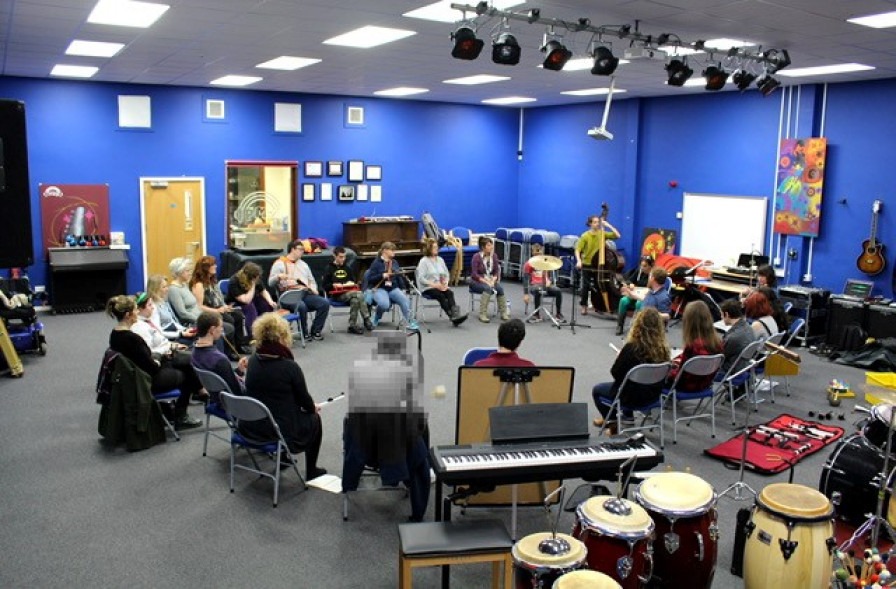Our Band with Plymouth Music Zone

Orchestra of the Age of Enlightenment (OAE) has completed the first year of Our Band a two year programme working in special schools in King’s Lynn, London, Southampton and in Plymouth, with students from Plymouth City College.
The OAE team on Our Band comprises our Education Director, Cherry Forbes, composers, animateurs and OAE players. Taking Purcell’s Dido and Aeneas as our starting point, we supported children and young people to create their musical response to this material which they performed to fellow pupils and family, alongside the OAE team who had worked with them over the year.
Anna Batson (Training & Research Manager/Music Leader) tells us about Our Band at Plymouth Music Zone.
As a very general overview of both the groups engaged with this years’ project, I witnessed a steady musical, social and emotional progress with nearly all of the participants, and very much a sense of ‘band’ and ensemble forming more quickly and solidly to some previous groups. This, I think, is possibly to do with some of the students being familiar with working with the Our Band team from being in previous cohorts. However, the OAE and PMZ’s partnership working is now deeply established and we have a very strong sense of what is needed within sessions to support everyone in the room, including one another as practitioners.
Skills shared within the Our Band team were: different leading styles, games and warm-ups, different ways of using technology to perform, record and capture music and sound, talking about ‘sound memories’, instrumentation and alternative ways of playing instruments (e.g. percussion); vocal leading and warm-up songs as well as the highly valuable end-of-day reflection sessions to talk through individual and group progress.
We had the privilege of meeting the students at three points during the year. With each chunk of time that passed in between, their identities and characters as young adults emerged more strongly each time we worked together. I learnt once again not to underestimate the participants’ ability to remember details about things like warm-up activities, songs, what the tutors were wearing, the colour of someone’s hair or a particular instrument they had enjoyed playing. Actions in songs and storytelling were popular and helped to trigger memories and also helped shape the songs and pieces structurally.
Threading the story of Dido and Aeneas through the work and having this theme with us consistently was an excellent framework for composition, listening and education activities with the wonderful OAE musicians and the creation of original work by the two groups.
With Cherry, I supported students with their diaries and reflections and co-facilitated question and answer sessions. This is usually the little bit of time that we never get to hear / see first-hand: the immediate impact of the project work. It was clear from these sessions that there was significant impact upon support staff as well, who expressed their enjoyment of being able to take part in their own right, as well as the opportunity to see the students in a very different context.
Multi-arts work developed from the input (including fabric and paper painting, drawings) and it was great to see the students in their college environment and their tutors working with them to extend the project in their own way. These additional project outputs provided students with alternative ways to express ideas and feelings.
Facilitators allowing space for one another’s approaches / ideas / input in a very respectful and supportive way where we were able to all learn from one another. This is one of the most powerful things for me about this working partnership and all the additional learning that takes place aside from the richness of working with the participants themselves.
Visual timetables were useful mapping tools for the group and staff and helped to reduce anxieties of some students who wanted to know what was going to happen and when.
The pacing of sessions allowed plenty of space for choosing opportunities and I think this increased confidence through handing over control to the participants. The participants then began to take increased responsibility for themselves and one another’s input.
For me, this project has been about building stories together – for example, ‘Albert’ started off as a conducting game in one of my sessions (when I was covering for the OAE musicians who were trying to get to Plymouth through driving snow!). The Albatross was my idea to use our arms outstretched like wings. If they were lowered on one side towards the floor, this meant we needed to create quietness and gradually raise and lower volume by using our arms. I was trying to use a link to the sea themes of the Dido and Aeneas story with the seabird and a physical action to help the group.
In a reflection session, I suddenly realised that one of the students had been thinking all along that I had been saying “Albert Ross” who was indeed not a man, but a seabird with a huge wingspan! Needless to say this was extremely endearing and hilarious … I even brought in a little ceramic Albatross to show the students to jog their memory of the activity. All of this little story had been built together and developed its own identity. In the sessions following this, all the OAE musicians and leaders also adopted Albert in activities that required some quietness.
This is just a little example of the kind of shared leading, learning from peers and the participants themselves has provided me with a rich learning platform and fed my own creative practice and encouraged me to share some of my approaches with the OAE. A few years ago I would not have felt as confident to do so (e.g. leading vocal warm-ups and singing sessions).
